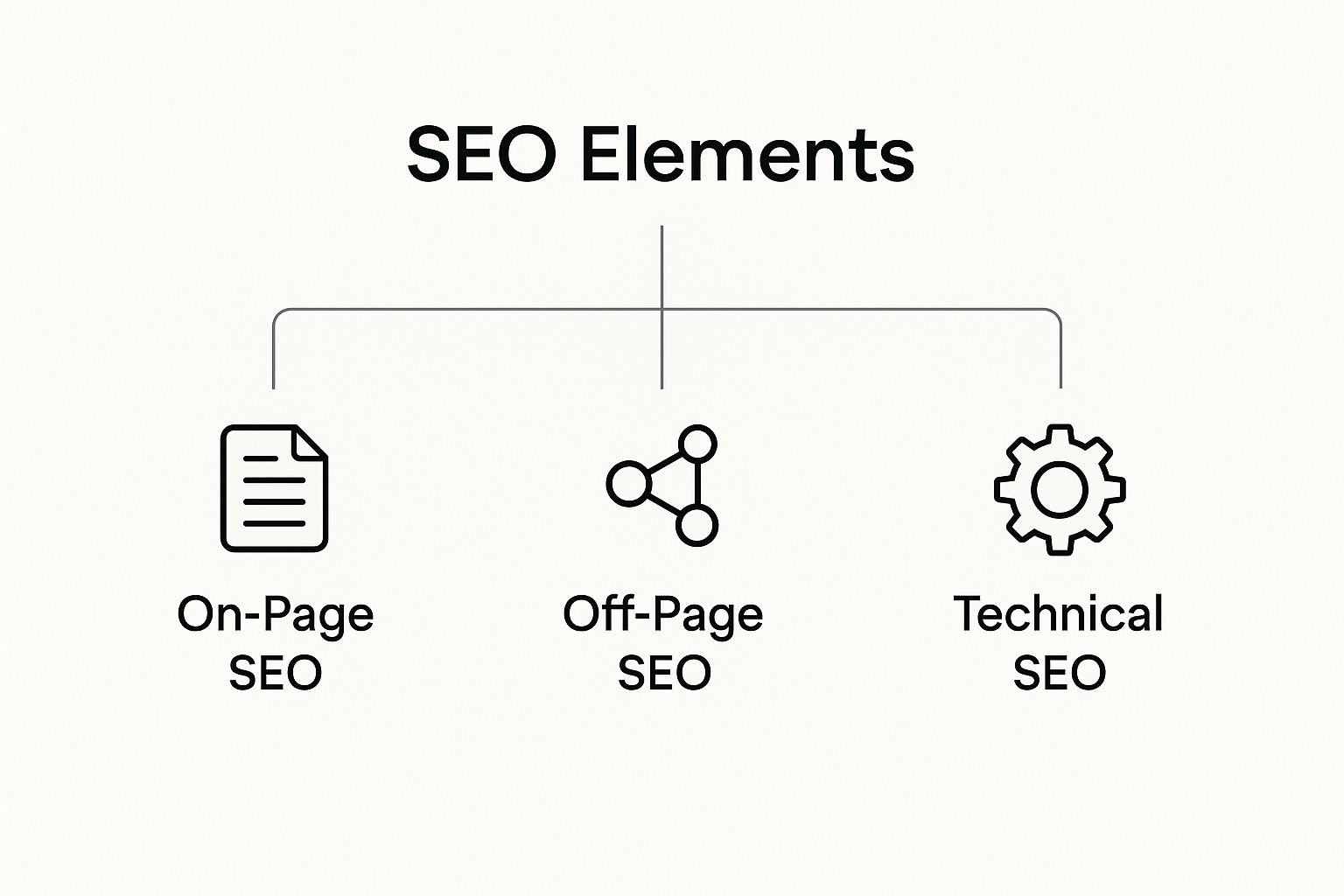At its core, Search Engine Optimization (SEO) is the practice of increasing the quantity and quality of traffic to your website through organic search engine results. Think of it as the art and science of signaling to search engines like Google that your content is the most authoritative and relevant answer to a user's query.
When executed correctly, SEO is a powerful strategy for driving consistent, high-value traffic month after month, without paying for every click.
How Does Search Engine Optimization Actually Work?

To understand how SEO works, imagine the internet as a colossal library with billions of books but no central filing system. SEO is the process of meticulously organizing your content so that search engines can find, understand, and trust it as a valuable resource for their users.
Fundamentally, it's a partnership. Your role is to create helpful, clear, and trustworthy content. The search engine’s role is to find that content and present it to the right people at the right time.
This interaction between your website and a search engine like Google is governed by a three-step process they use to make sense of the web's vast information.
Crawling, Indexing, and Ranking: The Core Process
First is crawling. Search engines deploy automated programs—often called "spiders" or "bots"—to explore the web. These bots follow links from one page to another, constantly discovering new and updated content.
Next comes indexing. Once a bot finds a page, the search engine analyzes its content—text, images, and videos—and stores that information in a massive database called an index. This index serves as the library's master catalog, ready to be searched in a fraction of a second.
Finally, there's ranking. When a user types a search query, the engine scours its index for all relevant pages. It then uses a complex algorithm, which considers hundreds of ranking factors, to order those pages. The ultimate goal is to present the most helpful and reliable results at the top.
SEO isn't about gaming the system. It's about creating a genuinely valuable user experience and clearly communicating your site's purpose to search engines so they can connect you with the right audience.
It All Comes Down to User Intent
Modern SEO transcends pleasing algorithms; it’s about deciphering user intent. You must understand what a searcher truly wants. Are they seeking information (informational intent), looking for a specific website (navigational intent), or ready to make a purchase (transactional intent)?
When you build content that directly addresses these underlying needs, you create something genuinely useful. This user-centric mindset is the key to long-term success, as search engines are engineered to reward websites that best serve their users. Focus on the person behind the screen, and you'll naturally align with search engine goals.
To simplify this complex field, it's useful to view SEO as having three main areas of focus. These "pillars" work in tandem to build a strong, visible online presence.
The Three Pillars of Modern SEO
These three pillars form the foundation of any effective SEO strategy. By balancing your efforts across all three, you create a well-rounded approach that search engines and users will both appreciate.
The Journey From Keywords to User Experience

To truly grasp what search engine optimization is today, it's essential to understand its evolution. The practice has transformed from a simple set of technical tricks into a complex discipline centered on the human experience.
In the early days of the web, SEO was akin to the Wild West. Marketers quickly discovered that they could manipulate early search engines by excessively repeating keywords on a page—a tactic now known as keyword stuffing.
These initial strategies focused on exploiting algorithmic loopholes rather than helping users. The goal was a quick jump in rankings, regardless of content quality. This approach, predictably, was not sustainable.
The Rise of Google and PageRank
Everything changed with the introduction of Google’s PageRank algorithm in the late 1990s. This was a monumental shift. For the first time, a search engine evaluated not just the words on a page but also the number and quality of links pointing to it. Each link acted as a vote of confidence, signaling that other websites found the content valuable.
This development forced a strategic overhaul. Off-page factors became critically important, sparking a race to acquire as many links as possible and giving rise to a new era of optimization tactics—some legitimate, some not.
The core idea behind modern SEO was born here: it’s not enough to simply tell search engines you’re relevant. You must prove your authority through great content and the recognition earned from others.
The Algorithm Strikes Back
As SEOs grew more adept at manipulating rankings, Google responded with major algorithm updates designed to improve search quality. These updates, given their own names, permanently altered the SEO landscape.
Two of the most famous updates were:
- Panda (2011): This update targeted websites with low-quality, thin, or duplicate content. Sites created solely to rank for keywords without providing real value were penalized, rewarding those with original, helpful information.
- Penguin (2012): This update focused on manipulative link-building schemes. It penalized sites that bought links or used spammy tactics to inflate their authority, reinforcing the need for natural, high-quality backlinks.
These updates sent a clear message: shortcuts were disappearing. The only sustainable path to success was through creating a genuinely great user experience.
From Keywords to E-E-A-T
This decades-long evolution has led us to the current people-first approach. SEO has transformed significantly over the past three decades. Early experiments in the 'Stone Age' (1990-1995) gave way to a 'Wild West' of hidden text (1995-2000), followed by a 'Gold Rush' of link exchanges (2000-2005) and an 'Industrial Revolution' of automated link farms (2005-2010), all designed to outsmart algorithms. You can dive deeper into the evolution of SEO and its different eras if you're curious.
Today, Google emphasizes concepts like E-E-A-T, which stands for Experience, Expertise, Authoritativeness, and Trustworthiness. Instead of just matching keywords, search engines now strive to understand the real-world credibility behind content. They want to know: does the author have firsthand experience? Is the website a trustworthy source?
This journey from simple keywords to complex concepts like user experience and trust illustrates why modern SEO is far more than a technical checklist. It’s about building a brand that both people and search engines can rely on.
Understanding The Three Core Types of SEO
Every robust SEO strategy is built upon three core pillars. Think of them like building a house: you need a strong foundation (Technical SEO), well-built walls and rooms (On-Page SEO), and a solid roof that adds credibility (Off-Page SEO).
Understanding how each pillar contributes to your website's visibility is the first step toward building a results-driven strategy. This framework is a practical way to organize your efforts and ensure comprehensive coverage.
This diagram breaks down how these three pillars work together.

As you can see, each branch is distinct, but they all grow from the same trunk. The shared goal is to create a strong, user-friendly presence that search engines can easily understand and reward with higher rankings.
On-Page SEO: The Content on Your Site
On-Page SEO encompasses all optimizations you can directly control on your website's pages. This involves working with your content and its underlying HTML code to make your pages as clear, relevant, and helpful as possible for both users and search engine bots.
The mission is to clearly signal to search engines what each page is about and which search terms it deserves to rank for. This extends beyond writing to include the strategic optimization of every on-page element.
Common on-page activities include:
- Content Creation: Developing high-quality articles, guides, and resources that genuinely answer the questions your audience is asking.
- Title Tag Optimization: Writing compelling, keyword-rich titles for your pages that entice users to click in search results.
- Internal Linking: Purposefully linking between relevant pages on your own site to help search engines understand your site’s structure and distribute page authority.
- Meta Descriptions: Crafting concise, persuasive summaries that appear under your title in search results to improve click-through rates.
Mastering these on-page elements lays a powerful foundation. For a deeper dive, check out our full guide on what is SEO.
Off-Page SEO: Building Authority Across The Web
Off-Page SEO includes all actions taken outside of your website to enhance its rankings. If on-page SEO is what you say about yourself, off-page SEO is what the rest of the internet says about you. It's about building your website's reputation and authority.
The primary component of off-page SEO is link building. A backlink—a link from another website to yours—acts as a vote of confidence. When a reputable site links to your content, it signals to Google that your page is a credible resource, thereby boosting your authority.
Off-Page SEO is fundamentally about earning trust. It’s a long-term game of building relationships and a strong reputation to prove to search engines that your website is a respected voice in its industry.
However, it's not solely about links. Other off-page signals also play a role:
- Brand Mentions: Even unlinked mentions of your brand on other sites are recognized by search engines as a positive signal.
- Social Signals: While not a direct ranking factor, shares and engagement on social media drive traffic and indicate content popularity.
- Guest Posting: Writing for other respected websites in your niche is an effective way to earn quality backlinks and introduce your brand to a new audience.
Technical SEO: The Foundation of Performance
Technical SEO ensures that your website's foundation is solid, allowing search engines to crawl and index your content efficiently. Without a technically sound site, even the best content and strongest authority signals can be rendered invisible. It is the critical, behind-the-scenes work that enables all other SEO efforts to succeed.
This pillar addresses your website's health and performance. The SEO industry is projected to be worth over $86.8 billion by 2025, highlighting its crucial role. With over 90% of online searches happening on Google, whose algorithm has evolved with AI like RankBrain and language models like BERT to understand user intent, a technically flawless site is non-negotiable.
Key elements of Technical SEO include:
- Site Speed: Ensuring your pages load quickly, as slow sites frustrate users and are penalized by search engines.
- Mobile Experience: Optimizing your site for a seamless experience on smartphones and tablets, which now account for the majority of web traffic.
- Structured Data: Implementing schema markup to help search engines understand the context of your content, which can lead to enhanced listings in search results.
To make these differences crystal clear, here’s a quick comparison of the three pillars.
On-Page vs. Off-Page vs. Technical SEO at a Glance
Each component is a specialty, but true success comes when they work in harmony. An effective strategy integrates all three to create a powerful, unified approach to driving organic growth.
Why SEO Is an Essential Business Investment

Now that we've defined what SEO is, the critical business question arises: why invest in it? The answer is far more significant than just "ranking on Google." View SEO not as a marketing expense, but as a core business strategy that builds a tangible, long-term asset.
Unlike paid advertising, which stops the moment you stop paying, SEO builds a lasting digital foundation. Every optimized piece of content and every quality backlink you earn contributes to a powerful compounding effect, driving traffic and leads for months or even years. It's an investment that appreciates over time.
Attracting High-Intent Organic Traffic
SEO's greatest strength is connecting you with people at the precise moment they need your solution. A person searching for "Salesforce integration for professional services" has an active, immediate problem. This high-intent traffic is invaluable, converting at a much higher rate than outbound marketing because you are meeting existing demand, not trying to create it.
By being present where motivated buyers are actively searching, organic search becomes one of the most efficient channels for customer acquisition.
Building Unmatched Brand Credibility
Ranking at the top of Google does more than generate clicks—it builds trust. Users instinctively trust organic search results more than paid ads. High rankings act as a powerful third-party endorsement from the world's most trusted information source, signaling that you are a credible authority in your field.
Every time a potential customer finds your content answering their questions, you solidify this expert perception, building brand equity and a competitive advantage that is difficult to replicate.
SEO is the process of earning trust at scale. It positions your brand as the definitive answer, building credibility and authority with every search query you rank for. This earned trust is an asset that pays dividends long after a paid campaign has ended.
Gaining Invaluable Customer Insights
Beyond traffic and trust, SEO provides a direct line into your customers' minds. The keywords they use, the questions they ask, and the content they engage with are a goldmine of market intelligence. Analyzing this search data reveals your audience's pain points, needs, and the exact language they use to describe them.
These insights are not just for marketing; they can inform product development, refine sales pitches, and shape overall business strategy. Understanding what your audience is searching for allows you to build better solutions. This feedback loop is a game-changer for staying ahead of the curve. To dig deeper into these advantages, our post on why SEO is important provides a closer look.
This strategic focus has a long history. The game changed in 1998 with Google’s PageRank algorithm, which began valuing quality links. Major updates like Florida in 2003, Panda in 2011, and Penguin in 2012 further cracked down on manipulative tactics, rewarding sites that focused on the user.
How to Measure SEO Performance That Matters
Executing a...(content truncated)





